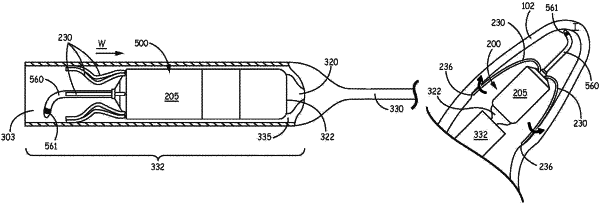| CPC A61N 1/057 (2013.01) [A61N 1/3756 (2013.01); A61N 1/37518 (2017.08)] | 20 Claims |

|
1. An implantable medical device comprising:
a device housing;
a pacing extension extending distally from a distal end of the device housing;
a pacing electrode mounted on a distal end of the pacing extension; and
a fixation member attached to the distal end of the device housing, the fixation member comprising a plurality of fingers,
wherein each finger extends from a fixed end to an arc and from the arc to a free end, wherein the arc defines an apex distal to the distal end of the housing, and wherein the each finger is configured to assume a relaxed condition and an extended condition, wherein:
the free end is proximal to the fixed end, proximal to the arc, and outward of the apex of the arc in the relaxed condition, such that the arc is between the free end and a longitudinal axis of the device housing when the each finger is in the relaxed condition,
the free end is distal to the fixed end, distal to the arc, and distal to the distal end of the device housing in the extended condition,
the pacing electrode is distal to the arc in the relaxed condition,
the each finger is configured to generate a spring force acting in a direction away from the device housing when the free end is displaced toward the device housing,
the plurality of fingers are configured to hold the pacing electrode against tissue when the free end of the each finger is displaced from the relaxed condition and toward the housing by a tissue surface, and
the plurality of fingers surround the longitudinal axis such that a first finger of the plurality of fingers contacts a first tissue surface and a second finger of the plurality of fingers contacts a second tissue surface opposing the first tissue surface when the plurality of fingers hold the pacing electrode against tissue.
|